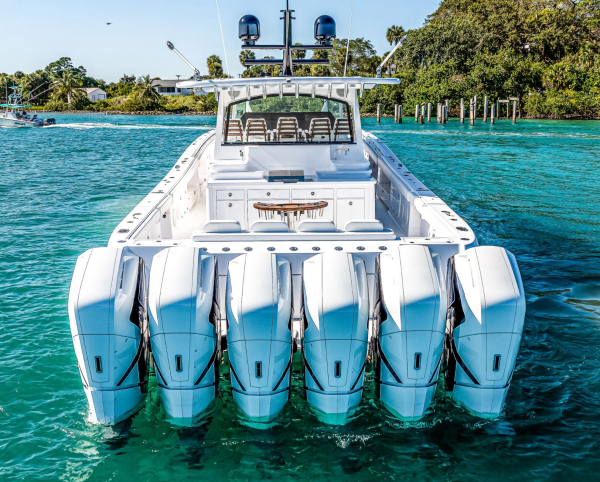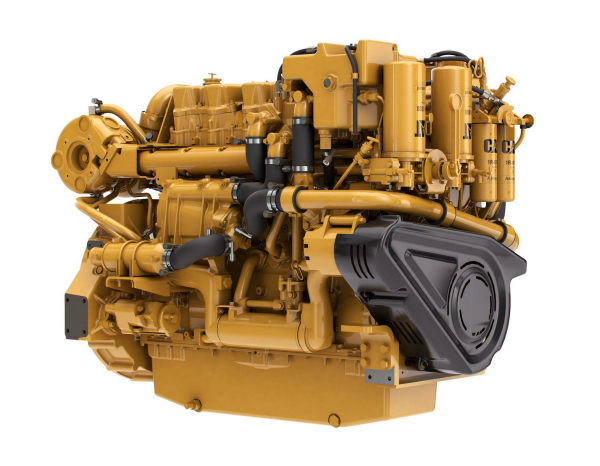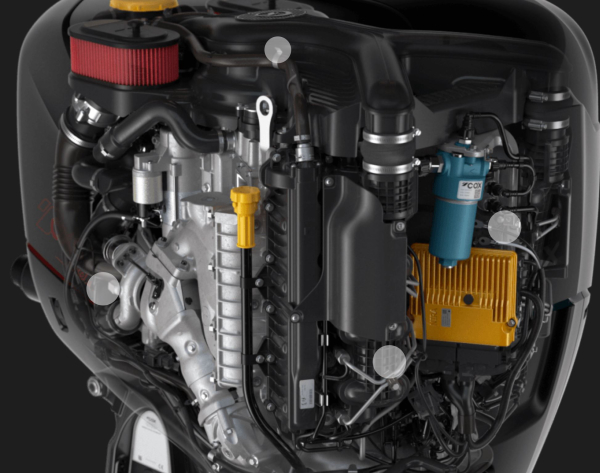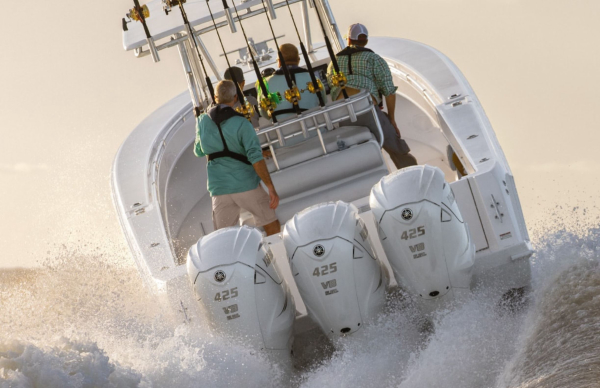If anyone in the boating industry still had any doubts, the recent Miami and Fort Lauderdale Boat Shows should have removed it. XXL outboards like the massive Mercury 600 or the muscular Yamaha 450 now rule the market for boats in the 30’ to 50’ range where diesel inboards were the only option just a few years back.
The king of the “mine is bigger than yours” race is currently the 65’ HCB Estrella—powered by six Mercury 600’s, for those of you with a spare $5,394,000!

All new boat packages on the upper end of the center console class are equipped with one, two, three or more monster outboards, and the big motors are now appearing on many sportfisher and cruising designs as well. Even a few trawler-style yachts are offered with outboard power.
The changeover is not surprising given the advantages of modern outboards. They not only generate enough torque to get big, heavy boats moving—the Merc 600 through an auto-shifting transmission—but they also produce top speeds far in excess of what inboards, gas or diesel, can manage in fishboats, cruisers and dayboats.
Though the big outboards are expensive—the Merc 600 has a base price of $77,000, the Yamaha 450 about $50,000, they’re not nearly as pricey as diesels like Volvo-Penta’s 1350 IPS drive, at around $192,000 per copy.
They are much quieter—some four-stroke outboards are almost silent at idle—produce no visible exhaust plume, and can be fueled at many more locations than can diesel boats.
Though the big outboards are beefy—the Merc weighs 1,260 the Yamaha close to 1,000 lbs--they’re not nearly as heavy as a Caterpillar C18 ACERT producing comparable horsepower, which weighs about 4,000 pounds, not counting running gear and costs over $100,000 including controls.

Though the inboard diesel can be mounted farther forward giving better weight distribution than outboards hung on a transom bracket, all that weight has a huge impact on both ability to get on plane and on top speed, as well as on fuel use/range.
And now, as we’ve gotten used to them—and manufacturers have made the housings more sleek and attractive—outboards are no longer considered as ugly mechanical blobs ruining the lines of a boat, at least in much of the market. (The genteel folks who love Downeasters and the like will take exception.)
The Advantages of Diesel Inboards
So far, if you have a really big boat, diesel remains the only game in town—diesels of 2,000 hp and more are available for those with truly deep pockets and the impetus to put lots of it into discretionary spending on a boat longer than 50 feet.
Diesels are also noted for life spans measured in decades rather than years like outboards. Bigger engines running slower wear out slower.
The Merc 600 has a projected lifespan of about 3,000 hours. The Cat C18 ACERT has a projected lifespan of 18,000 to 20,000 hours. On a per hour basis, the Cat is a much better investment, especially for those who run long hours daily—offshore charter fishers, ferry boats and the like.
Inboard engines allow a much cleaner transom and a broad, open swim platform where it’s easy to launch diving expeditions, swim or even carry a dinghy. Outboards are in the way for all of this activity.
And diesel fuel is much less explosive than gasoline. While modern fuel systems combined with good maintenance minimize the risk of gasoline, it’s still there—rarely a week goes by without a gas-powered boat going boom somewhere at a U.S. marina. The ability of gasoline vapors to explode from the tiniest spark creates much greater risk.
What the Future Holds

We have not yet seen the end of the horsepower race in gas outboards. And there are a few diesel outboards like those from Cox Marine, which offers models to 350 hp, combining some of the best from both worlds, including durability, low fuel consumption and fuel safety.
Yamaha has reported experimenting with hydrogen fueled outboards, and also recently bought Torqeedo Electric Motors, which makes some muscular models in their Deep Blue series, the largest of which reportedly generates the equivalent of 134 horsepower at full throttle.
The company has not hinted at building any larger gasoline-fueled outboards, but don’t hold your breath after Mercury had a gangbusters result for their XL models at FLIBS. Yamaha’s skunkworks on the Tennessee River may produce some even more impressive internal combustion muscle if the market for big outboards continues to thrive.

Electric power has shown some impressive results in boats, including a top speed over 115 mph on a hydroplane. But electric boat motors are thus far plagued by the same issues as electric cars, availability of rapid charging facilities, range anxiety, and battery weight, cost and life span.
In short, the recreational boating propulsion market is evolving rapidly, and five years down the road we are sure to see some very different looking power choices. The one thing we can apparently be sure of is that they won’t be cheaper, no matter who’s in the White House.
— Frank Sargeant
Frankmako1@gmail.com